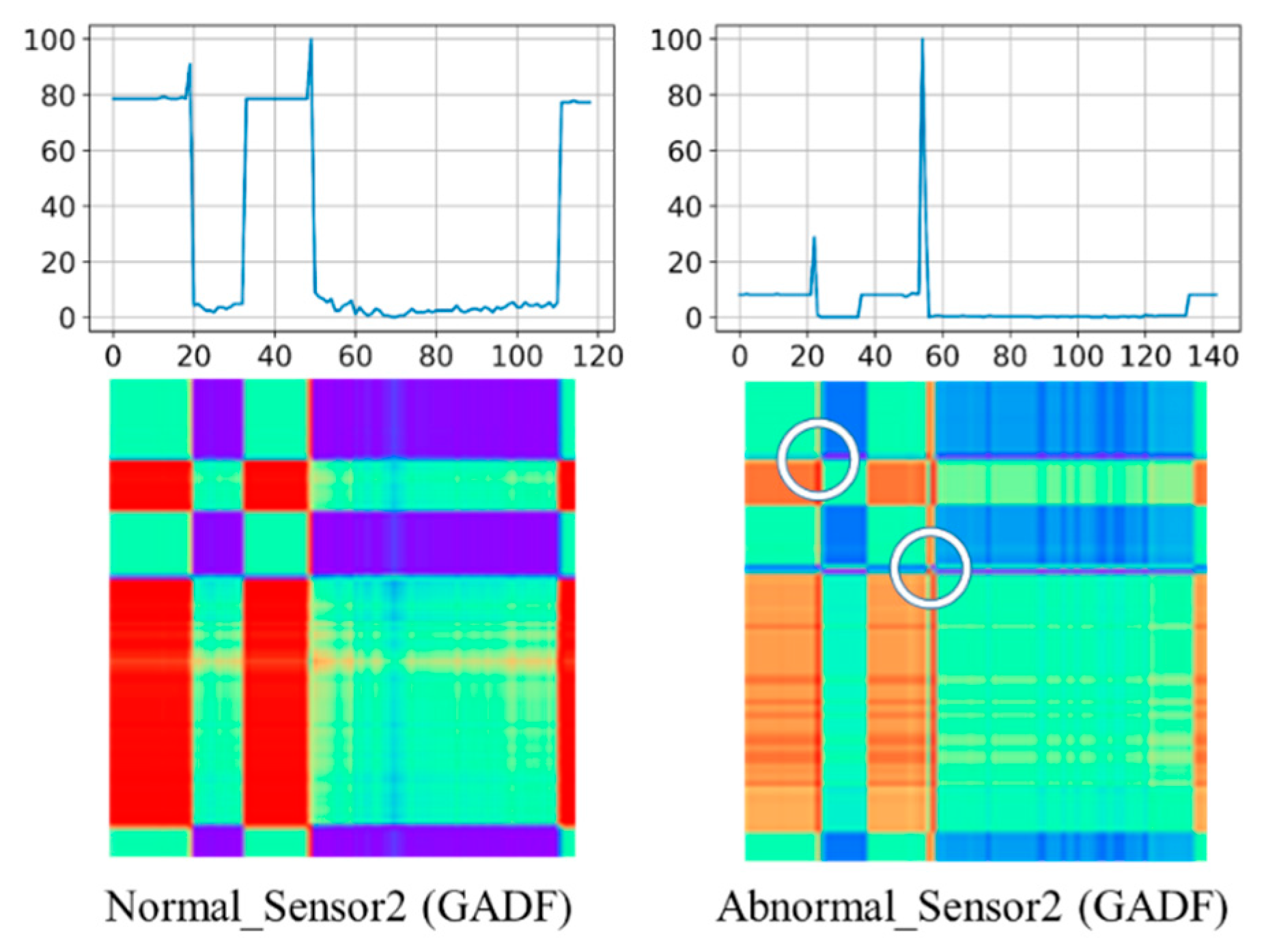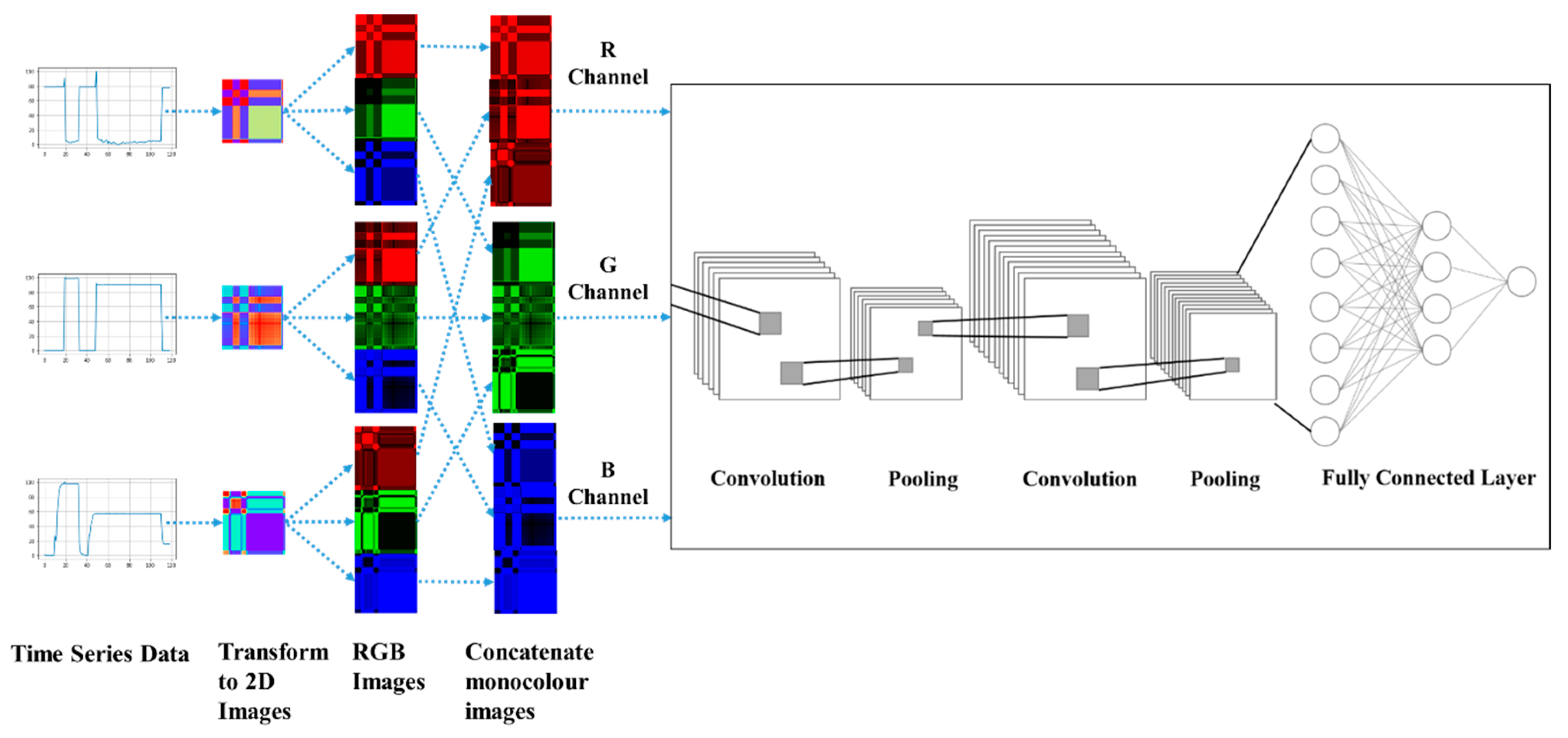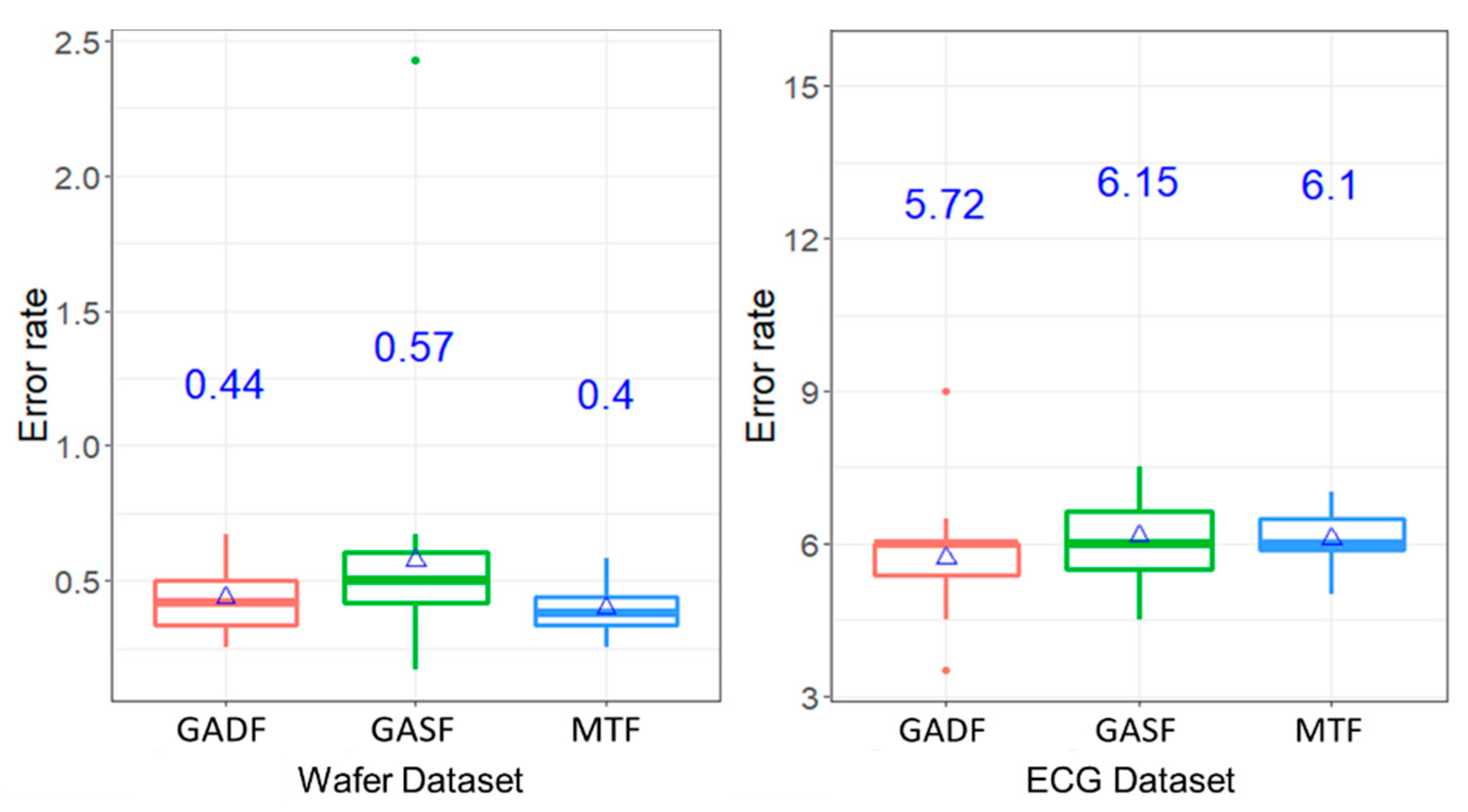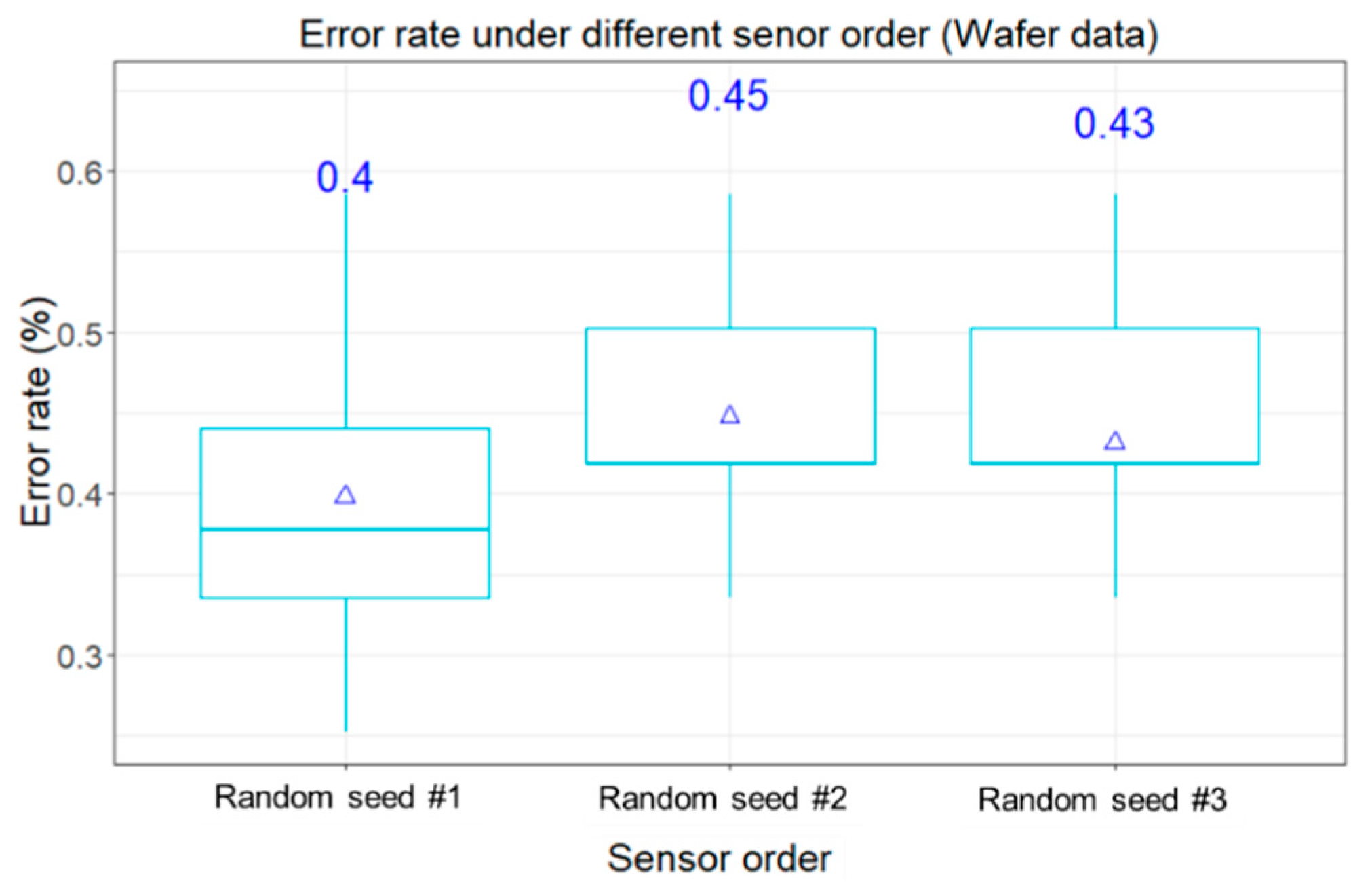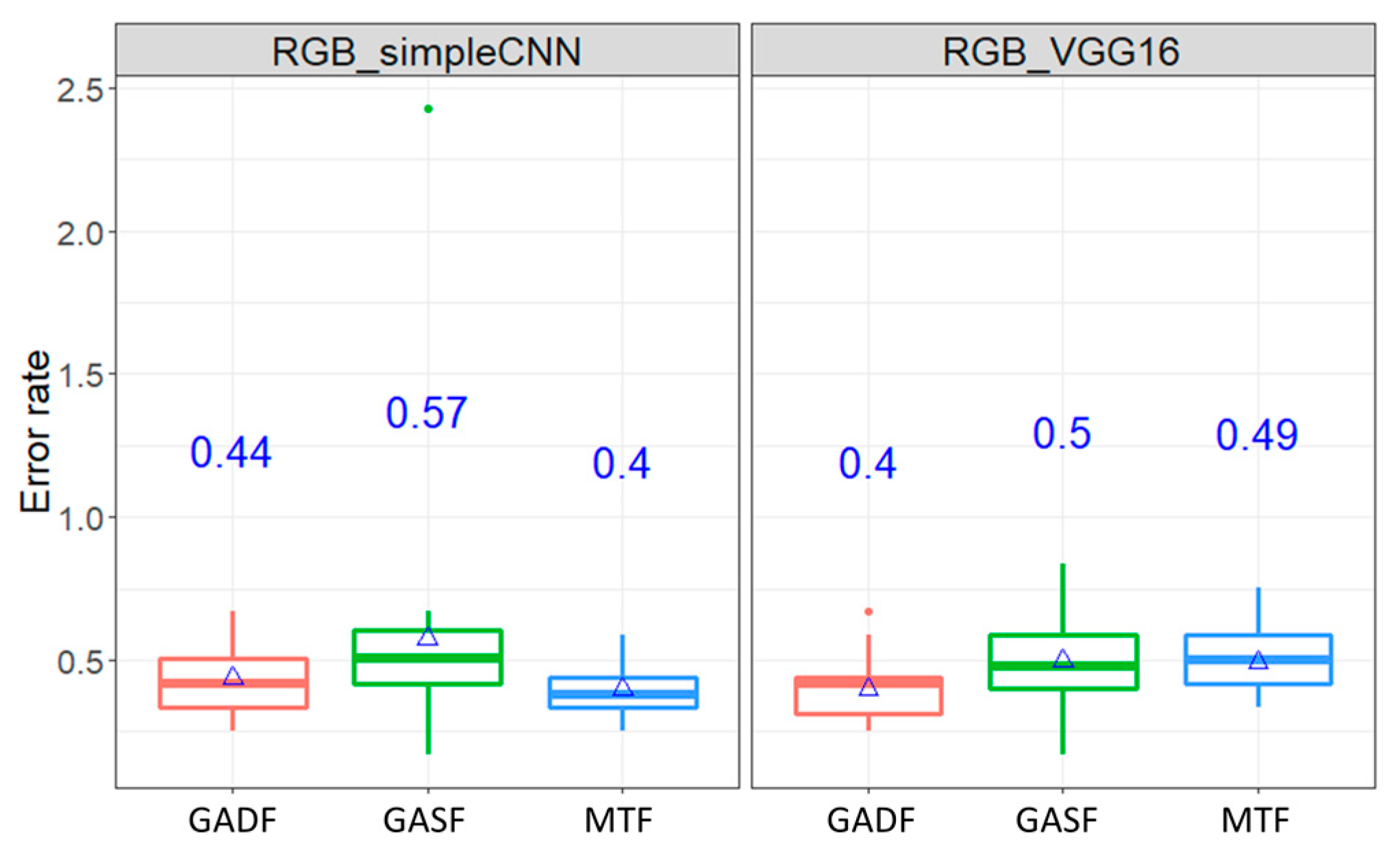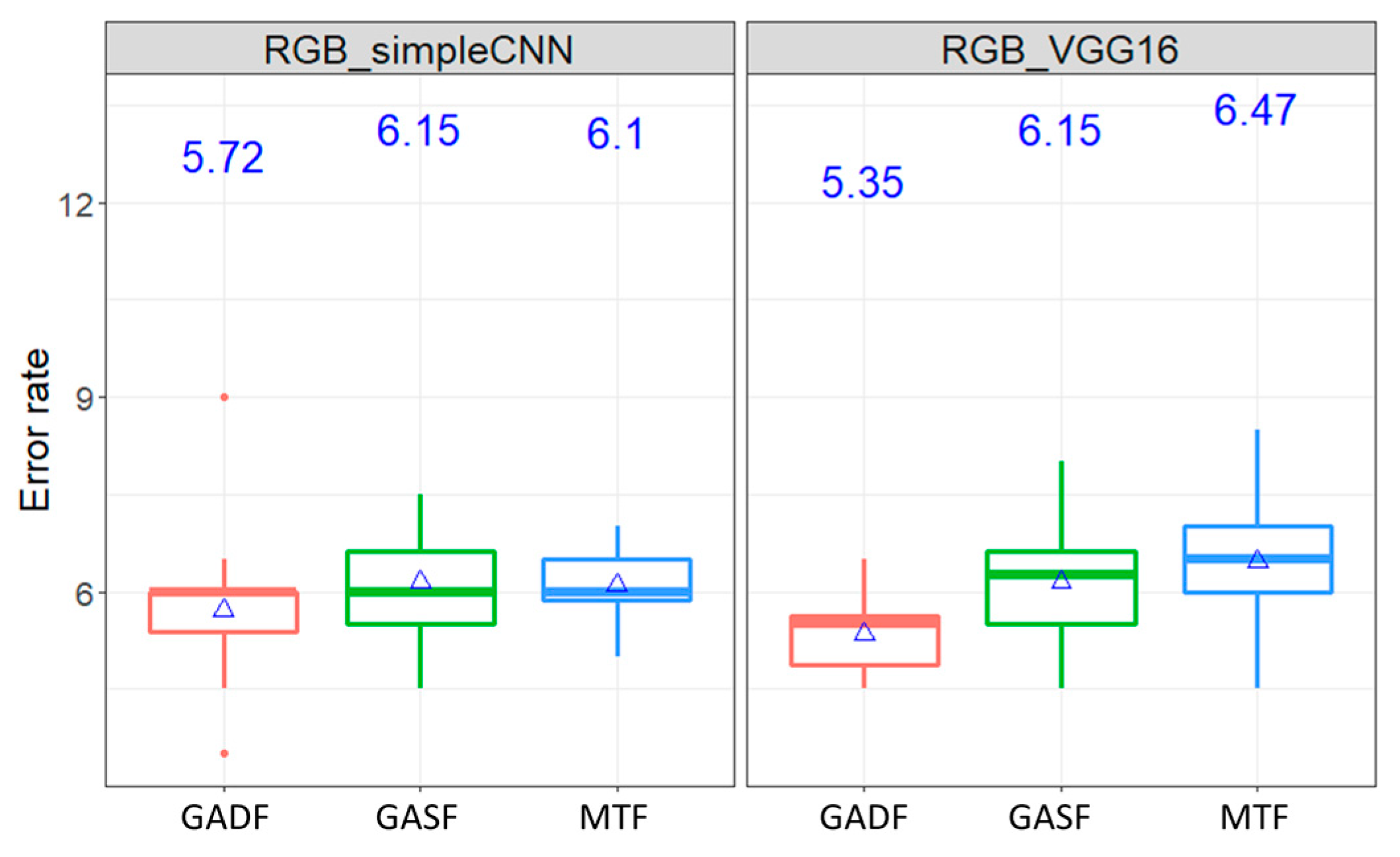1. Introduction
In the era of data explosion, time series data, which is a series of data points indexed in time order, is one of the most common data collected. A variety of time series data can be collected from the internet, machines, devices, and sensors for all kinds of applications such as monitoring, tracking, and pattern classification. Multivariate time series (MTS) data from multiple resources can be used to present the operating statuses of the machines, or human health condition such as electrocardiography. In smart manufacturing, building a binary classification model by machine learning algorithm to identify defects or tool wearing (normal or abnormal) from the collected time series data is also a popular approach to improve production quality [
1].
Assume a time series
is a set of data points indexed in time order,
, where
represents the length of the time series data [
2]. Górecki and Łuczak defined an MTS
as multiple univariate time series, such that
,
, where
is the number of univariate time series in
that also represents the dimension.
An MTS can be considered as a
matrix. Generally, MTS data mining research can be categorized into: (1) representation and indexing, (2) similarity measure, (3) segmentation, (4) visualization, and (5) mining [
3]. Essentially, MTS classification belongs to a “mining” area that tries to categorize multiple time series as class labels [
4]. There have been several challenges in dealing with high-dimensional data for MTS classification. For instance, a univariate time series usually includes a lot of noise in the process of collecting data. The noise issue is compounded in MTS, which is composed of multiple univariate time series. Another challenge is MTS classification tools have to not only recognize the data features but also consider the correlations among the variables.
In the early years, traditional time series analysis techniques such as: Simple Exponential Smoothing (SES) [
5], Autoregressive Integrated Moving Average (ARIMA) [
2], and dynamic time warping (DTW) method [
6], which were used for analyzing MTS data for measurement or estimation. Combining with different measurement techniques, multiple machine learning methods such as decision tree [
7], Support Vector Machine (SVM) [
8], neural network [
9], and so on have been proposed to solve the MTS classification problem.
Lately, with the maturity of deep learning technology and advances in Graphics Processing Unit devices, many studies used deep learning frameworks to address MTS classification problems. Fawaz et al. reviewed multiple deep learning methods and specified an overview of the different deep learning approaches for time series classification [
10]. In their review, deep learning approaches for MTS classification can be categorized as two main models: the generative and the discriminative models. By exhibiting an unsupervised training step to find a good representation of time series that precedes the learning phase of the classifier, generative models were considered as model-based classifiers [
11]. On the other hand, a discriminative deep learning model directly learns the mapping between the inputs of MTS and class outputs with the feature engineering and model tuning. To avoid the ambiguity, in this research, we focus on developing a discriminative deep learning model based on image-based time series data representation, considered as an innovative preprocessing of feature engineering.
Among versatile deep learning models, Convolutional Neural Network (ConvNet) has gained rapid adoption. This method can extract more features and details from the input image, classify and predict classes more precisely than previous machine learning algorithms. Researchers had applied it to solve problems in different fields, of course that includes MTS classification (TSC) problems. By directly using time series data as inputs, Zheng et al. proposed supervised feature learning with ConvNet to classify time series data [
12]. Gamboa also adopted ConvNet for time series analysis and obtained promising results [
13]. Yazdanbakhsh and Dick used same size segments in time series with sliding window to transform an image and applied Dilated Convolutional Neural Network for classification [
14].
Instead of using raw time series data as input, Wang and Oates first encoded univariate time series data into different types of images, namely, Gramian Angular Fields (GAF) and Markov Transition Fields (MTF), as inputs of ConvNet [
15,
16]. In fact, this image-based framework initiated a new branch of deep learning approaches which consider image transformation as one of feature engineering technique. The transformation of time series into images was inspired from the computer vision feature extraction concept. By learning spatially invariant filters (or features) from raw input time series, ConvNet method diminished the problems of: (1) temporal information is lost and (2) the features learned are no longer time-invariant which are with the traditional multi-layer-perceptron approach. In their most recent work, Chen and Shi followed the same framework adopting Relative Position Matrix with ConvNet, called RPMCNN, to perform the classification by the transform 2D images from time series data as inputs [
17]. Their results all showed promising performances by converting univariate time series data to 2D images as an input of ConvNet.
Although the result of encoding time series data as image representation for ConvNet is promising in improving classification accuracy, most of the previous works only considered encoding univariate time series data as one image for a single channel of ConvNet’s input. In other words, when MTS data are collected, how to combine the information of MTS image as inputs of ConvNet is still an open domain. In addition, for an MTS classification problem, the framework of considering colors of MTS images for ConvNet is needed. Therefore, in this research, we proposed an innovative framework which transforms one batch of MTS data into multiple images and concatenating them as bigger two-dimensional images as inputs of ConvNet. The deep learning architecture of ConvNet was then applied to extract and learn features from these images for classification purpose. Three typical methods of encoding MTS data into images, the sequences of image concatenation and two kinds of ConvNet architectures were investigated. Two open multivariate datasets which are the benchmarks datasets were used to evaluate the experiment results. The results show that proposed framework can enhance the accuracy of MTS classification by using the relatively simple network. In short, we conclude this work as the followings:
This work aims to extend 2-D image transformation method for MTS classification from the univariate time series input to MTS inputs;
The proposed innovative image concatenation can combine MTS data as multiple color channels as inputs of ConvNet;
The proposed framework can enhance the accuracy of MTS classification by using the relatively simple network;
The result shows the selection of image transformation methods and the sequence of image concatenation are not significant for classification accuracy.
The rest of the paper is organized as follows:
Section 2 provides a review of MTS, data encoding methods, and ConvNet;
Section 3 describes the methodologies of data transformation, image aggregation, and ConvNet hyperparameter setting;
Section 4 explains the experiments and results; and
Section 5 presents the conclusion and suggestions for future research.
3. Methodology
This research is to propose a framework to classify MTS data using deep learning technology. This study first applied MTF, GASF, and GADF to transform MTS data into images. Then, the transformed images were concatenated for processing by ConvNet to identify features in the images for classification. Basically, this framework consists of four steps: (1) dimension reduction of time series, (2) image encoding, (3) image concatenation, and (4) ConvNet classification model training.
Figure 3 shows the workflow of the proposed framework for MTS Classification by ConvNet. The details of this framework are introduced in the following sub-sections.
3.1. Dimensionality Reduction Using Piecewise Aggregate Approximation (PAA)
An image is composed of pixels, so it can be considered as a
matrix, where
n defines the image size. When the length of the time series data is
n, the image size of any kind of transformation method is
[
26]. As each batch of time series data can vary in length, the straight transformation of the original data into images will result in different sizes of images. Therefore, to obtain images of the same size for ConvNet, in this research, Piecewise Aggregate Approximation (PAA) method is applied to perform dimension reduction of the original time series data before transforming time series data into images [
32]. Please note that applying PAA is also the convention method for data preprocessing before transferring time series to images [
17].
PAA divides original time series into
N equal-length segments.
N is the length of the reduced times series that should satisfy the constraint of 1 ≤
N ≤
T. Then, the mean value of each segment substitutes the original time series to reduce the dimensionality from
T to
N. Suppose a time series
where
is the length of the original time series.
T/
N denotes as the length of each segment. It also means the original time series
x will be divided by
N segments and the reduced time series can be denoted as
based on Equation (7) where
l is the index of the reduced time series. If
,
is the mean of the original time series; If
,
is the original time series. In this research, in order to synchronize the image size,
N is determined by the shortest length of MTS. Inevitably, the information losing on the longer timer series occurs. Although PAA will reduce the dimensionality of some time series, the result shows the classification can be improved based on concatenating multiple time series. The more detailed information can be found in
Section 4.
3.2. Time Series Data Encoding As Images
In this study, a 3-dimensional matrix is formed to contain the MTS. First, a time series data is encoded as a color image which has two dimensions using the GDF or MTF method. As the image can be of any color, adding one more dimension to represent the color is required. For example, the image can be represented with 3 color channels by red, green, and blue (RGB). Then, 3 elements in the first dimension exists. Please note that more colors can be used for representing more color channels. In this work, only RGB channels were to evaluate the concept of the framework.
3.3. Image Concatenation
MTS data transformation produces multiple images (one image for each univariate time series). These images have to be combined before feeding the ConvNet. This study adopted the concatenating method proposed by Yang et al. [
33]. For RGB image aggregation, each colored image was first separated into three monochroic images: red, green, and blue (RGB) in this case. Then these monocolor images were concatenated together as a bigger image.
Figure 4 illustrates the framework of concatenating RGB images. Please note that if more time series data are used as inputs for classification, more 2D images will be generated accordingly. However, only three RGB channels will be constructed in this case. Basically, this design is to maintain the same number of the input channels of the network structure which will benefit on keeping the ConvNet network structure simple. This design is particularly convenient to apply on the domains such as anomaly detection where the time series data can be processed on the edge computing from a variety of sensors, and the image files can be uploaded as inputs of ConvNet which might be in the different location such as on cloud computing environment.
There is an interesting issue regarding the “spurious edge” created by concatenating 2D images. The question is if the “spurious edge” influences the classification? In order to study this issue, an experiment was designed to evaluate the sequence of concatenating 2D images. The concatenated images with different sequence of the 2D images (the different patterns of “spurious edges”) are compared with their classification performance. The experimental result shows the patterns of “spurious edges” will not significantly influence the classification result. The details of this experimental results can be found in
Section 4.
3.4. The Architecture of a ConvNet
In this study, for each time series data, the size of 2D transformed image is fixed at pixels. Due to the nature of the proposed concatenation method, if m time series exists, the size of the input image for the ConvNet is fixed at for each monochrome channel. For RGB images, three channels will be allocated.
In order to assess whether the complexity of ConvNet architecture affects the classification accuracy, in this research, two kinds of ConvNet, noted as the simple ConvNet and VGG16, are studied. VGG16 proposed by Simonyan and Zisserman is the model won the ImageNet Large Scale Visual Recognition Competition (ILSVRC) in 2014 [
20].
For the simple ConvNet, we adopted the very popular model devised by Palm [
34]. Two convolutional layers with a kernel size of
, two max pooling layers with a
pixel window and stride of 2, and one fully-connected layer are suggested. After max pooling, the height and width of the input image becomes half. The learning rate was set to 0.0023 and the rectification non-linearity was applied to all hidden layers as the activation function based on the setting suggested in [
19]. To prevent the overfitting problem, the early stopping method was implemented according to the suggestion in [
35]. This method can also reduce memory and decrease computation time.
Because VGGNet uses more layers and smaller size of convolutional filters to construct the deeper depth of network structure, in this work, we consider VGGNet as a larger network for learning which is expected to classify images more accurately. This research adopted the typical VGG16, which has 13 convolutional layers with a kernel size of
, 5 max pooling layers with a
pixel window and 3 fully-connected layers. The learning rate was set to 0.00023 based on [
20]. Most of the learnable parameters are used in the first fully-connected layers. The number of learnable parameters in VGG16 is 201,330,688, which is 800 times larger than the simple ConvNet (251,542). Obviously, VGG16 can be expected to spend more execution time and memory than typical ConvNet.
4. Experiments and Results
In this work, three series of experiments were conducted to evaluate the impact of: (1) the image transformation methods, (2) the sequences of concatenating images, and (3) the structure complexity of the network. As mentioned earlier, the first experiment was to evaluate the significance of utilizing image transformation methods: GASF, GADF, and MTF methods as inputs of ConvNet. The second experiment aimed to study the impact of “spurious edges” which are generated by concatenating images. The different sequences of concatenating 2D images were evaluated to check if the classification performance was affected by the sequence, or “spurious edges” of concatenated images. The performances of different random sequences are compared with each other. The third experiment focused on evaluating if the more complicated network structure is able to further improve the classification accuracy.
The MTS data were transformed by three methods (GASF, GADF, and MTF) using the pyts package [
36]. All experiments were carried out in Python 3.6 coding environment. The deep learning frameworks were built in PyTorch 1.1. The tests were conducted on a computer with Intel
® Core I7-8700K CPU 3.7 GHz, 64GB RAM, GeForce GTX Titan Xp video card, and Windows 10.
4.1. Introduction of Data Set
In this study, two popular MTS datasets, benchmark datasets for binary classification of MTS data, were used to evaluate the performance of the proposed framework. The Wafer dataset was collected from six vacuum chamber sensors that monitored the manufacture of semiconductor microelectronics. The ECG dataset in which exactly one heart beat exists per series was collected from two electrodes that recorded heartbeats as normal or abnormal. Both of the datasets were provided by Olszewski [
31] and the classes of both datasets are binary (normal or abnormal). The details of these two datasets are described in
Table 1.
The data length can be different in each batch, but within the same batch, the data length is the same for all sensor variables. As the range of values collected by multiple sensors is different, the data were normalized to between 0 and 1. Then the data were smoothed using the PAA mentioned in
Section 3 before transformation into images.
4.2. Performance Evaluation
Five-fold cross validation was applied to avoid overfitting problem. It also means for each fold, 80% of the data was used for training the simple ConvNet and VGG16 while the remaining 20% was used to test the deep learning tools. The accuracy rate and the error rate are the common measures to evaluate the performance of a classification tool. Equation (8) shows the formula to calculate the error rate. When the predicted class is the same as the actual class, the value of
is 1, or 0 otherwise.
is the total number of testing data in each dataset.
4.3. Experimental Results
In this research, three experiments were conducted. Each experiment used the five-fold cross validation and ran for 20 times to obtain the mean value of error rate. The first experiment investigated the impact of image transformation method GASF, GADF, and MTF under the proposed RGB image concatenation using the simple ConvNet. The second experiment evaluated the impact of the sequence of concatenating images. The third experiment explored whether the more complex architecture of the ConvNet can produce better classification results.
4.3.1. Experiment #1: Comparison of Image Transformation Method
Figure 5 shows the boxplot of the average error rates by classifying classes of Wafer dataset under RGB images inputs of ConvNet. As mentioned earlier, three image encoding methods: GADF, GASF, and MTF were used. As can been seen, the mean error rates, indicated in the blue ink on the center of the plot, are between 0.4% and 0.57% for Wafer dataset. Similarly, the average error rates by the case of ECG dataset are between 5.72% and 6.15%.
Further statistical analysis, through the Dunn tests, was conducted to determine whether different image transformation methods affect the error rates. Based on the results presented in
Table 2, the error rates are not significantly different among pairwise comparison of the three methods in the ECG dataset under 95% confidence interval. Although the mean error rates of GASF and MTF, which are the largest and lowest in the Wafer dataset, respectively, are significantly different, the pairwise comparisons between GASF and GADF, and between GADF and MTF are not significant. In short, the selection of the image transformation seems not to affect the classification result in terms of error rates.
4.3.2. Experiment #2: Comparison of Different Sequences of Concatenating Images
In this experiment, only Wafer dataset was used because ECG has only two time series which cannot represent the complication of different image concatenation. In the Wafer dataset, each batch contains data collected from six sensors. Hence, the transformed images from the sensors can be arranged in various sequences. The concatenation can be arranged based on the different randomness. Different sequences generated different concatenated images. Without losing the generality, the concatenation of RGB images was conducted to clearly show “spurious edges” by MTF transformation which has shown the better result in the Wafer dataset.
By following the same framework in Experiment #1,
Figure 6 shows the box plot of 20 classification results under three different sequences that are based on different random number seed in the experiment. No matter which sequence was applied, the means of classification errors are around 0.4~0.45. The Wilcoxon Signed Rank Test was applied to check the pairwise comparison among these three random sequences. The statistical test also confirmed no significantly difference on the classification performance under the pairwise comparisons. It means the sequence of concatenating the images will not significantly influence the classification. This test also demonstrated that the ConvNet is able to learn image features regardless of the sequence of concatenation (or the patterns of edges).
4.3.3. Experiment #3: Comparison of Different Architectures of ConvNet
In the third experiment, two architectures of ConvNet: simple ConvNet and VGG16, were represented as the simple and complicated network structures, respectively. It is worth noting that VGG16 has the more complicate (deeper) network than simple ConvNet.
Figure 7 shows that in the Wafer dataset, the average error rates under the simple ConvNet and VGG16 fall between 0.4% and 0.57%. The average error rates range from 5.35% to 6.47% in the ECG dataset, as shown in
Figure 8. It can be seen, for each network structure, there is no significant different under different transformation methods. Further statistical analysis through the Kruskal–Wallis’s analysis of variance (Kruskal–Wallis ANOVA) proves that the error rates of these two ConvNet architectures are insignificantly different (
p-value = 0.87 in the Wafer dataset and
p-value > 0.999 in the ECG dataset). It simply means the complicated network structures does not necessarily guarantee better classification results.
Table 3 shows the execution times of the simple ConvNet and VGG16 in processing the Wafer dataset and ECG datasets. It is obvious to show that VGG16 took more than ten times longer than the simple ConvNet in processing time, but the prediction accuracy improvement was insignificant. In short, the results of experiments show the interesting insights: encoding MTS data into colored concatenating image as inputs of the simple ConvNet can significantly improve the classification, however, the complicated network might not further improve it.
4.4. Comparison of Different Classification Tools
In literature, many methods were proposed to classify binary classes in Water and ECG MTS data.
Table 4 enumerates the error rates conducted by different methods [
4,
37,
38,
39]. Please note that the average error rates are all limited to one-dimensional data transformation except our proposed methods starting with “concat”. As shown in this table, the proposed framework which uses three encoding methods with RGB by ConvNet produces better prediction accuracy in classifying Wafer and ECG datasets, indicated as bold face. In fact, the proposed concat-MTF-RGB can generate the best result (error rate = 0.4) in Wafer dataset while concat-GADF-RGB can obtain the best result (error rate = 5.35) in ECG dataset when comparing with previous works in literature. Therefore, once again, we can conclude that concatenating the encoded RGB images from multivariate time series data as the inputs of ConvNet following the proposed framework can significantly improve the classification accuracy, especially for the binary classification problems.
5. Conclusions
MTS classification tries to classify multiple univariate time-series data and predicts a class based on the learned patterns. This study proposed a framework of concatenating 2D images transformed from time series data as RGB input channels for ConvNet training. In this work, by following the convention, three image encoding methods: GASF, GADF, and MTF were used to encode MTS data into two-dimensional images after PAA dimension reduction. Then the MTS 2D images were concatenated as a big image separated by RGB channels to feed into ConvNet for binary classification. In order to investigate the impacts of: (1) the transformation methods, (2) the sequence of concatenation, and (3) the complexity of network structure on classification performance, a series of experiments were conducted. Three transformation methods, three different random sequences of concatenation (only for Wafer dataset), and two kinds of ConvNet architectures (simple ConvNet vs. VGG16), were used to assess the effects of these adjustments on the prediction accuracy.
Based on experimental results, the proposed framework applying the concatenated RGB images and with simple architecture of ConvNet can significantly improve the classification results. It is interesting that the selection of encoding methods does not affect the prediction outcome significantly. Also, the sequence of image concatenation is not significant for classification accuracy. These findings actually release the troublesome of choosing the image transformation method and the order of image concatenation.
Besides, the experiment of conducting the two ConvNet (simple and complicated VGG16) show they produced insignificantly different results based on colored concatenating images as inputs. This “simple is enough” finding can enlighten MTS classification practitioners that always starting with the simple network rather than complicated one when applying deep learning methods on MTS classification problem. Again, the proposed framework with encoding images and simple ConvNet architecture was compared with other methods published in the past literature. The proposed framework produced promisingly the lowest error rates in both Wafer and ECG datasets where multivariate variables are inputs to classify binary class (normal vs. abnormal).
There are several future directions to further study the model. First, in this work, only one ConvNet was used for training data. Another framework which utilizes parallel ConvNets for each time series data and joins them in the last layer for prediction can be constructed. It would be worth evaluating if the parallel network will improve the accuracy. Second, developing a transformation method that can preserve both the dynamic and static information in the temporal range at the same time, or filter out irrelevant noise in the time series may be helpful to increase the feature distinctiveness in the images. Third, it might be interesting to check if more monochrome than RGB can improve the classification further. Last but not least, as the current framework was applied in binary classification datasets only, multiclass classification can be explored to assess the proposed framework performance.
